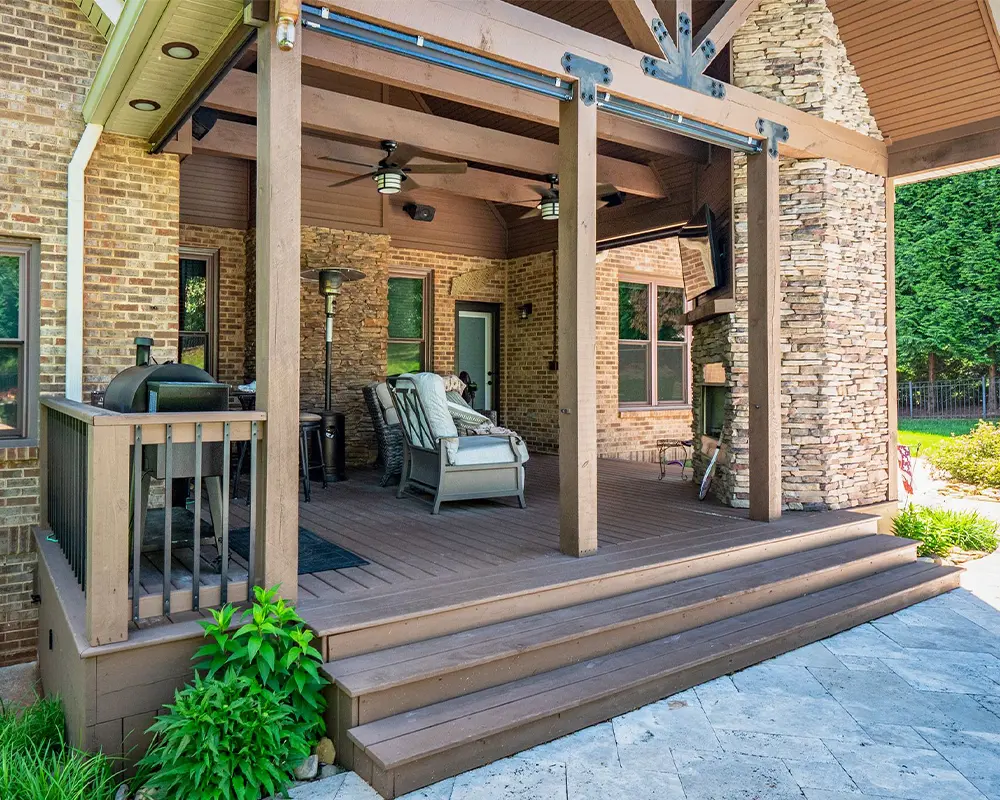Find peace of mind by hiring a certified deck installer Austin who knows the local building codes.
Find peace of mind by hiring a certified deck installer Austin who knows the local building codes.
Blog Article
How to Pick the Right Materials for Your Deck Installation Project
Selecting the proper products for your deck installment task can appear overwhelming. The trick is to stabilize your budget plan, design choices, and way of living needs to create a deck that will certainly boost your exterior area for years to come.
Comprehending the Different Kinds of Deck Materials
When beginning on a deck installation task, the option of materials becomes a crucial decision. Numerous options are available, each with unique attributes and aesthetic allure. Conventional wood, for example, uses a timeless, all-natural look and is normally a lot more cost-efficient. Nonetheless, it can warp in time and calls for regular maintenance. Compound materials, on the various other hand, are a blend of wood and plastic, giving toughness and resistance to weather aspects. They demand less upkeep contrasted to timber however are generally a lot more expensive. One more option is plastic, which is basically maintenance-free and immune to bugs and rot, albeit less natural-looking. By recognizing these differences, house owners can make a much more enlightened decision on one of the most suitable deck material for their details demands.
Reviewing the Resilience and Maintenance Requirements of Deck Materials
Evaluating the durability and upkeep demands of deck products is a critical action in deck installment. Durability involves the material's ability to hold up against rough climate condition, deterioration, and its longevity. For example, cedar and redwood are naturally immune to rot and bugs, making them sturdy options. On the various other hand, pressure-treated timber, while resilient, may call for more upkeep due to its sensitivity to splitting and buckling.
Recognizing maintenance demands is just as crucial. Some materials need routine securing or tarnishing to maintain their look and stand up to moisture damage, while others, like composite outdoor decking, require much less upkeep. By evaluating these elements, one can pick one of the most appropriate outdoor decking material, guaranteeing an equilibrium between resilience, maintenance needs, and visual appeal.
Expense Analysis: Comparing Timber and Composite Decking
Although cost might originally seem like a secondary issue, it is a significant aspect when contrasting timber and composite outdoor decking. On the other hand, composite decking, while costlier at first, calls for less upkeep, potentially lowering long-lasting costs. Prospective deck proprietors should consider their spending plan and desire to maintain their decks when determining between timber and composite decking.
Looks and Design Versatility of Decking Materials
While expense is a vital consideration, the aesthetic allure and layout adaptability of decking materials also play a substantial duty in the decision-making process. Various materials offer varying degrees of visual appeal. Natural wood outdoor decking gives a classic, timeless look, while composite materials use a wide array of colors and textures to fit diverse tastes and designs. Layout flexibility refers to the ability to shape and adjust the decking material to meet specific design requirements. Timber, as an example, supplies high layout versatility because of its simplicity of reducing and forming. Composite materials, while less adaptable in style, are still adaptable enough for most deck designs. These variables, therefore, are vital components in the option of decking material.
Environmental Influence of Decking Products
When choosing outdoor decking materials, one have to take into consideration not only aesthetic appeals and description longevity, but also the ecological effect. It's important to evaluate the sustainability of products and check out recycled outdoor decking options. Recognizing the prospective influence on neighborhood communities will certainly ensure an extra eco liable choice.
Assessing Material Sustainability
In the realm of deck building, examining product sustainability is a crucial action. Composite outdoor decking products usually integrate timber and plastic, reducing the demand for brand-new timber but boosting dependence on fossil gas - deck installer austin. Thus, the selection of decking products should stabilize functionality, appearances, price, and sustainability to ensure a responsible and long-lasting setup.
Recycled Decking Alternatives

Compound outdoor decking is especially preferred due to its durability and ease of maintenance. Recycled plastic decking, on the other hand, is extremely durable and needs very little upkeep.

Effect on Local Ecosystems
While the benefits of utilizing recycled materials for decking can not be overstated, it's equally essential to consider the more comprehensive ecological effects of these selections. Correct disposal of old outdoor decking is essential to reducing land fill waste. Essentially, an eco-conscious deck task demands mindful product option, sustainable sourcing, and liable disposal.
Making Your Final Choice: Tips for Choosing the Best Deck Materials
As the post shifts right into the subtopic of "Making Your Last Decision: Tips for Picking the very best Deck Materials", it is important to comprehend the selection of deck materials offered. Striking an equilibrium between durability and visual appeal is essential in this option process. The adhering to discussion will certainly assist visitors in making an informed option based on these essential factors to consider.
Understanding Different Deck Materials
The job of picking the right materials for your deck installation can seem discouraging due to the substantial variety of alternatives available. Nevertheless, understanding the different products can hop over to here streamline this process. Wood is a prominent selection, providing a traditional aesthetic and affordability. Kinds of wood used consist of pressure-treated lumber, cedar, and redwood. Compound products, made from a mix of timber and plastic, are low-maintenance and immune to rot and insects. Plastic or PVC decks are much more sturdy and call for less upkeep than composite products, yet they can look less natural. Aluminum decks are strong, lightweight, and resistant to rot, however they are also the most pricey choice. Each material has its very own benefits and disadvantages, making it critical to consider your specific needs prior to making a decision.
Longevity vs. Visual Appeals Equilibrium
Balancing toughness with looks can be a challenge when selecting deck products. The decision commonly boils down to individual choices and the deck's meant usage. High-traffic areas might necessitate sturdy products like composite decking, which stands up to deterioration however might do not have the natural elegance of wood. On the other hand, timber uses a classic appeal and heat that synthetic materials battle to duplicate. It needs more upkeep and may not last as long. Homeowners need to strike an equilibrium, thinking about both the deck's practical needs and their aesthetic preferences. By doing so, they can guarantee their deck remains a practical and eye-catching outdoor room for years to find.
Final thought
In final thought, selecting the ideal materials for your deck installation project requires mindful factor to consider of elements such as sturdiness, upkeep, expense, looks, and ecological effect. Whether you choose typical wood or composite products, your option ought to straighten with your spending plan, style choices, and way of life. Inevitably, the most effective decking material is one that enhances your outdoor area and gives enjoyment for many years to come.
Report this page